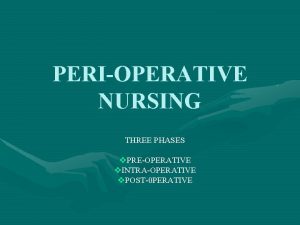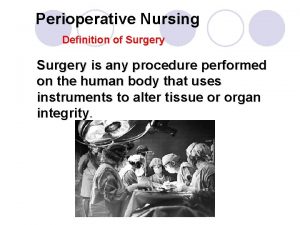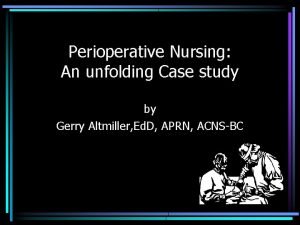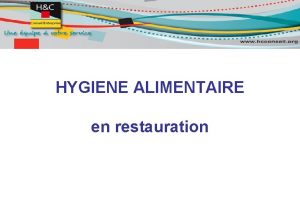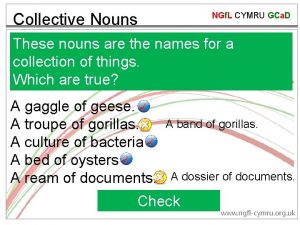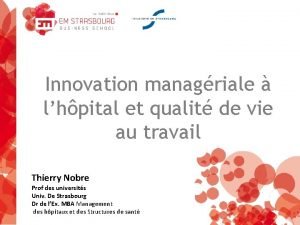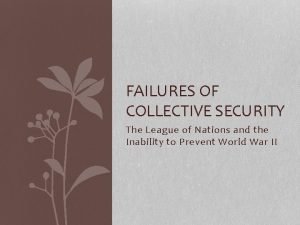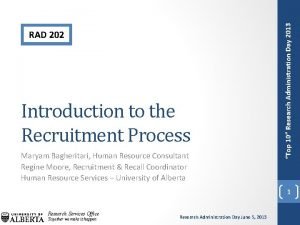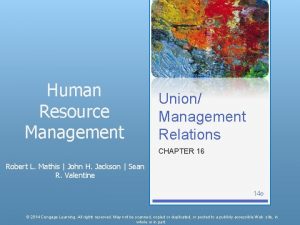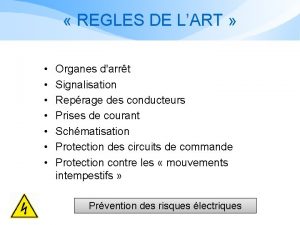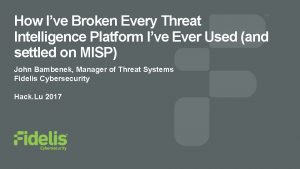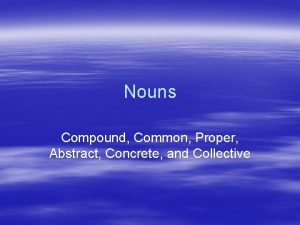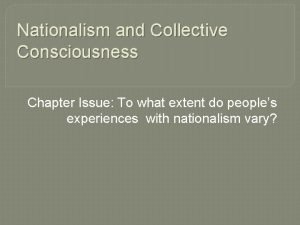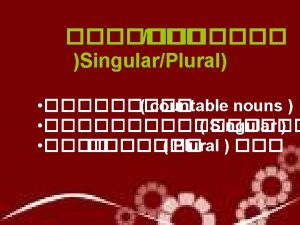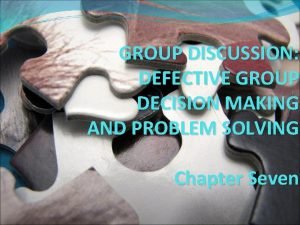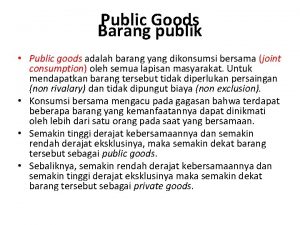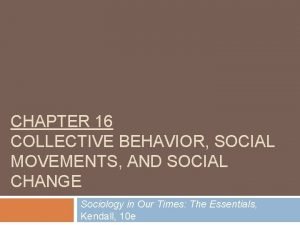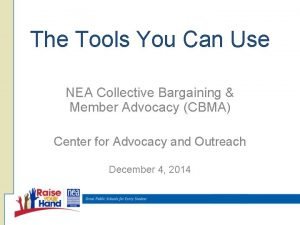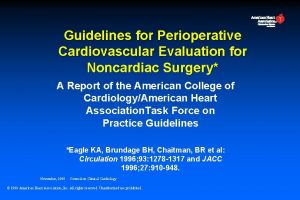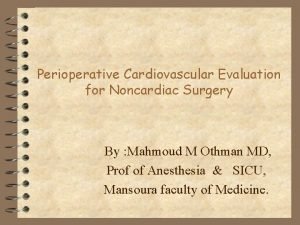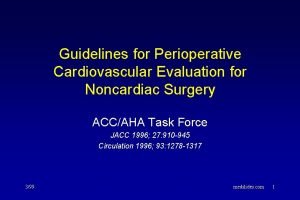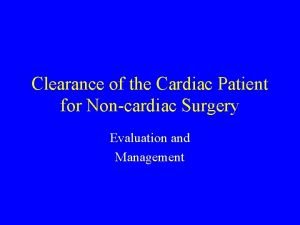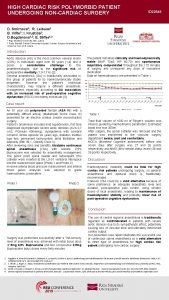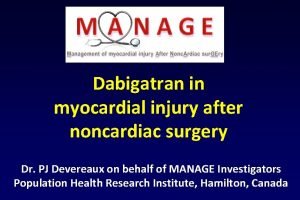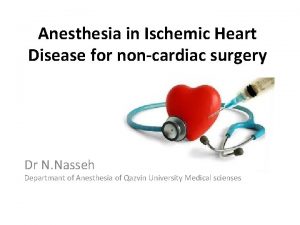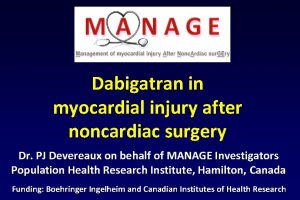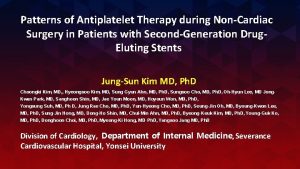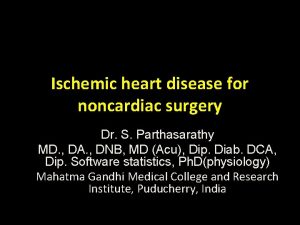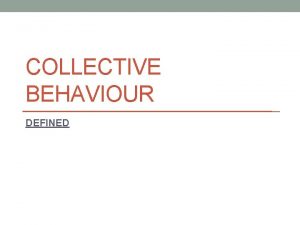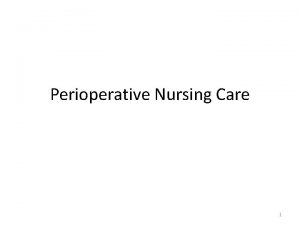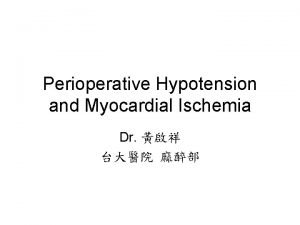COLLECTIVE REVIWE Perioperative cardioprotection in noncardiac surgery R




































































- Slides: 68

COLLECTIVE REVIWE Perioperative cardioprotection in non-cardiac surgery R 2 Jutamas Srisung Advisor : Maj. Wiriya Homhol

Introduction More patients with cardiovascular comorbidity presenting for surgery • Cardiac death is the third leading cause of perioperative death in the United States. • 8% of patients over 45 years suffer from myocardial injury after noncardiac surgery, 10% of them died. Cardiac complications in patients undergoing major noncardiac surgery. N Engl J Med 2015; 373: 2258 -69.

Preoperative, Intraoperative, and Postoperative Factors Associated with Perioperative Cardiac Complications Cardiac complications in patients undergoing major noncardiac surgery. N Engl J Med 2015; 373: 2258 -69.

Preoperative Prediction of Cardiac Complications Three methods for estimating perioperative cardiac risk: • Clinical risk indexes - Revised Cardiac Risk Index (RCRI) - National Surgical Quality Improvement Program risk index for Myocardial Infarction and Cardiac Arrest (NSQIP MICA) • Noninvasive cardiac testing • Measurement of cardiac biomarker level Cardiac complications in patients undergoing major noncardiac surgery. N Engl J Med 2015; 373: 2258 -69.

The Revised Cardiac Risk Index Clinical variables Intrathoracic, intra-abdominal, or suprainguinal vascular surgery Ischemic heart disease History of congestive heart failure History of cerebrovascular accident or TIA Creatinine > 2 mg/d. L Insulin treatment of diabetes mellitus Score 1 1 1 Score Risk of CV event 0 0. 4% 1 0. 9% 2 6. 6% >2 11% - Lee TH, Marcantonio ER, Mangione CM et al. Circulation 1999; 100: 1043 -49 - Cardiac complications in patients undergoing major noncardiac surgery. N Engl J Med 2015; 373: 2258 -69

National Surgical Quality Improvement Program risk index for Myocardial Infarction and Cardiac Arrest (NSQIP MICA) • underestimates actual risk because the definition of myocardial infarction in the study was based only on electrocardiographic changes • Web-based or open-source spreadsheet for calculation Cardiac complications in patients undergoing major noncardiac surgery. N Engl J Med 2015; 373: 2258 -69.


Noninvasive cardiac testing • Recommend preoperative cardiac stress testing in patients with limited functional capacity • Limited functional capacity with elevated risk of a major cardiac event and the result would influence treatment Cardiac complications in patients undergoing major noncardiac surgery. N Engl J Med 2015; 373: 2258 -69.

2014 ACC/AHA guideline on perioperative cardiovascular evaluation and management of patients undergoing noncardiac Surgery. Circulation 2014; 130: e 278 -e 333.


Noninvasive cardiac testing Circulation 2014; 130: e 278 -e 333.

Cardiac biomarker level

Cardiac biomarker level Kristensen S, Knuuti J, Saraste A, et al. Eur Heart J 2014; 35: 2383– 431

Perioperative drugs • Aspirin • Beta-blockers • Statins • Alpha-2 agonists

Aspirin • Inhibition of platelet aggregation • Anti-inflammatory effects • On the contrary, increasing operative blood loss may predispose to perioperative myocardial ischemia Wong SSC, Irwin MG. Peri-operative cardiac protection for non-cardiac surgery. Anaesthesia 2016; 71(Suppl. 1): 29– 39

POISE 2 trial • High-risk patients undergoing non-cardiac surgery • No significant difference in the 30 -day risk of death or nonfatal MI between the aspirin and placebo • Increased risk of major bleeding in the aspirin group • Stopping aspirin for 3 or more days preoperatively and resuming 8– 10 days postoperatively when the bleeding risk is diminished was suggested. Devereaux PJ et al. Aspirin in patients undergoing noncardiac surgery. New Engl J Med 2014; 370: 1494– 1503.

• In high-risk patients undergoing non-cardiac surgery, perioperative aspirin reduced the risk of MACE without increasing bleeding complications. • Aspirin withdrawal was associated with a significantly higher rate of MACE. Oscarsson A et al. To continue or discontinue aspirin in the perioperative period: a randomized controlled clinical trial. Br J Anaesth 2010; 104: 305– 12

Continuation of aspirin is reasonable in patients with high-risk CAD or cerebrovascular disease, where the risks outweigh the risks of bleeding. Circulation 2014; 130: e 278 -e 333.


Beta-Blockers • Reduce heart rate and systemic blood pressure improving the myocardial oxygen balance • Shift myocardial metabolism towards glucose and reduce free fatty acid and Inflammation, stabilize atherosclerotic plaques Wong SSC, Irwin MG. Peri-operative cardiac protection for non-cardiac surgery. Anaesthesia 2016; 71(Suppl. 1): 29– 39

DECREASE trial • Bisoprolol reduces the perioperative incidence of death from cardiac causes and nonfatal MI in high-risk patients who are undergoing major vascular surgery Poldermans D et al. The effect of bisoprolol on perioperative mortality and myocardial infarction in high-risk patients undergoing vascular surgery. New Eng J Med 1999 ; 341: 1789– 94.

• Beta blockade started within 1 day or less before non-cardiac surgery prevents nonfatal MI but increases risks of stroke, death, hypotension, and bradycardia. Wijeysundera DN et al. J Am Coll Cardiol 2014; 64: 2406– 25

Cohort study, 962 patients • Beta-blockers improve outcomes more if given for longer before surgery. • Titrate the dose for optimal heart rate without hypotension • Allow anti-inflammatory effects to develop • Acute administration of beta-blockers is associated with increased mortality. Ellenberger C et al. Anesthesiology 2011; 114: 817– 23.

Retrospective study, 38, 779 patients • There may be benefit in starting beta blockers in patients according to an individual patient’s cardiovascular risk • Perioperative withdrawal of Beta-blockers is associated with increased mortality. Wallace A, Au S, Cason B. Association of the pattern of use of perioperative b-blockade and postoperative mortality. Anesthesiology 2010; 113: 767– 71


Slowly titrated to appropriate heart rate and blood pressure targets • More than 1 day (when possible at least 1 week to 1 month) before surgery, starting with a low dose • Resting HR goal of 60 -70 bpm with SBP 100 mm. Hg for the whole perioperative period • High doses should be avoided, particularly immediately before surgery. Kristensen S, Knuuti J, Saraste A, et al. Eur Heart J 2014; 35: 2383– 431

Kristensen S et al. 2014 ESC/ESA Guidelines on noncardiac surgery: cardiovascular assessment and management. Eur Heart J 2014; 431– 2383 : 35

Statins Reduce plasma lipid levels by inhibiting 3 -hydroxy-3 -methyl-glutaryl. Co. A (HMG-Co. A) reductase • Pleiotropic effects : improved endothelial function, vasodilation, anticoagulation, platelet inhibition, reduction in vascular inflammation and oxidization and stabilization of atherosclerotic plaques • Generally safe with a low incidence of adverse effects Wong SSC, Irwin MG. Peri-operative cardiac protection for non-cardiac surgery. Anaesthesia 2016; 71(Suppl. 1): 29– 39

Cohort study, 967 patients • Withdrawal of perioperative statin therapy for at least four days was associated with more incidence of myocardial injury compared with continuation of statins Le Manach Y et al. The impact of postoperative discontinuation or continuation of chronic statin therapy on cardiac outcome after major vascular surgery. Anesth Anal 2007; 104: 1326– 33.

Meta-analysis of 29 RCTs • Initiation of statins in statin-naive patients reduced perioperative MI in high risk cardiac procedures (RR 0. 48, p < 0. 001; NNT 17) and a trend of a reduced mortality at 1 year • Benefit in non-cardiac surgery is less clear. Guay J, Ochroch EA. Effects of adding statins before surgery on mortality and morbidity: a meta-analysis. J Cardiothorac Vasc Anesth 2014; 28: 255– 66

Systematic review of 16 RCTs in statin-naïve patients • Significant reduction in - mortality (RR 0. 53, P = 0. 03) - myocardial infarction (RR 0. 54, P < 0. 001) - perioperative atrial fibrillation (RR 0. 53, P<0. 001) - length of hospital stay (mean difference 20. 58, P <0. 001) de Waal BA, Buise MP, van Zundert AA. Perioperative statin therapy in patients at high risk for cardiovascular morbidity undergoing surgery: a review. Br J Anaesth 2015; 114: 44– 52.

• Decrease the perioperative incidence of mortality and MI in patients undergoing non-cardiac surgery • Significant reduction in mortality and MI in patients treated for more than 1 week prior to surgery de Waal BA, Buise MP, van Zundert AA. Perioperative statin therapy in patients at high risk for cardiovascular morbidity undergoing surgery: a review. Br J Anaesth 2015; 114: 44– 52

Circulation 2014; 130: e 278 -e 333

Eur Heart J 2014; 35: 2383– 431

Alpha-2 agonists Act on the locus coeruleus to reduce central sympathetic activity and peripheral noradrenaline release Attenuate the adrenergic stress response to surgery. Reduction in heart rate Improve myocardial oxygen balance

• RCT, 190 patients with or at risk for coronary artery disease undergoing noncardiac surgery • Perioperative administration of clonidine significantly reduces the incidence of perioperative myocardial ischemia and postoperative death. Wallace AW, Galindez D, Salahieh A, et al. Anesthesiology. 2004; 101: 284– 93.

RCT, 10, 010 patients at risk for atherosclerotic disease undergoing non-cardiac surgery • Low-dose clonidine vs placebo • Clonidine did not reduce the rate of death or MI. • Increase the risk of clinically important hypotension and nonfatal cardiac arrest. Deveraux PJ, Sessler DI, Leslie K, et al. Clonidine in patients undergoing noncardiac surgery. New Engl J Med 2014; 370: 1504– 13

Meta-analysis of 20 studies • Dexmedetomidine did not show significant improvement in cardiac outcomes following non-cardiac surgery. - All-cause mortality - Non-fatal myocardial infarction - Myocardial ischemia • Perioperative hypotension and bradycardia were significantly increased. Biccard BM, Goga S, de Beurs J. Dexmedetomidine and cardiac protection for non-cardiac surgery: a meta-analysis of randomised controlled trials. Anaesthesia 2008; 63: 4– 14

Alpha-2 agonists are not recommend for prevention of cardiac events. (class III; no benefit) Circulation 2014; 130: e 278 -e 333

Perioperative intervention

RCT, 510 patients with clinically significant coronary artery disease undergoing vascular surgery • Pre-operative coronary artery revascularization did not reduce longterm mortality or postoperative MI compared with medical treatment. Mc. Falls EO, Ward HB, Moritz TE, et al. Coronary-artery revascularization before elective major vascular surgery. New Engl J Med 2004; 351: 2795– 804

Perioperative intervention Coronary artery bypass and percutaneous coronary intervention are procedures that are associated with significant risk. • Patients with coronary stents are at risk of in-stent thrombosis during surgery, particularly if antiplatelet drugs are stopped Wong SSC, Irwin MG. Peri-operative cardiac protection for non-cardiac surgery. Anaesthesia 2016; 71(Suppl. 1): 29– 39

Performing PCI before non-cardiac surgery should be limited to • Patients with left main disease whose comorbidities preclude bypass surgery without undue risk • Patients with unstable CAD who would be appropriate candidates for emergency or urgent revascularization Circulation 2014; 130: e 278 -e 333.

Intra-operative anesthesia

Ischemic preconditioning (IPC) • A brief period of myocardial ischemia protects the myocardium from subsequent larger magnitude ischemia and reperfusion injury • Lowering of the metabolic demand of cardiac muscle • Infarct size limiting by effects of ischemic preconditioning • Ischemic postconditioning is attenuated to reperfusion injury Healy DA et al. Remote ischaemic preconditioning as a method for perioperative cardioprotection: Concepts, applications and future directions. Int J Surg 2014; 12: 1093 -99

Remote ischemic preconditioning (RIPC) • A brief period of ischemia in a distal organ can also exert a cardioprotective effect during subsequent cardiac ischemia • Endogenous substances such as calcitonin gene-related peptide, adenosine, and bradykinin released from the distal ischemic organ into the bloodstream to the heart and activate intracellular pathways Healy DA et al. Remote ischaemic preconditioning as a method for perioperative cardioprotection: Concepts, applications and future directions. Int J Surg 2014; 12: 1093 -99

Healy DA et al. Remote ischaemic preconditioning as a method for perioperative cardioprotection: Concepts, applications and future directions. Int J Surg 2014; 12: 1093 -99

Minamino T. Cardioprotection From Ischemia/Reperfusion Injury. Circ J 2012; 76: 1074 – 1082

Intra-operative anesthesia • Volatile anesthetic agents • Propofol • Opioids • Nitrous oxide

Volatile anesthetic agents • Volatile anesthetic agents protect rabbit myocardium from subsequent ischemia by coronary occlusion. • led to the concept of anaesthetic pre-conditioning • Direct endothelial protection Cope DK et al. Volatile anesthetics protect the ischemic rabbit myocardium from infarction. Anesthesiology 1997; 86: 699– 709

• volatile anaesthetics were effective in postconditioning, where exposure at the beginning of reperfusion after ischemia was cardioprotective • The mechanism of action involves G-protein coupled receptors, protein kinase C, adenosine Receptors and mitochondrial potassium channels and mitochondrial metabolism Wong SSC, Irwin MG. Peri-operative cardiac protection for non-cardiac surgery. Anaesthesia 2016; 71(Suppl. 1): 29– 39

• Many RCTs showed no evidence to support the clinical use of volatile anesthetic agents for cardioprotection in non-cardiac surgery. - Zangrillo A et al. Volatile agents for cardiac protection in noncardiac surgery: a randomised controlled study. Journal of Cardiothoracic and Vascular Anesthesia 2011; 25: 902– 7. - Lurati Buse GA et al. Randomized comparison of sevoflurane versus propofol to reduce peri-operative myocardial ischaemia in patients undergoing noncardiac surgery. Circulation 2012; 126: 2696– 704.

Propofol • Propofol has cardioprotective effects. • Free radical scavenging • Enhance mechanical recovery and tissue ATP levels after ischemia and reperfusion Kokita N et al. Propofol improves functional and metabolic recovery in ischemic reperfused isolated rat hearts. Anesth Analg 1998; 86: 252– 8.

• RCT in 385 patients at cardiovascular risk undergoing major non-cardiac surgery • Sevoflurane vs Propofol • No difference in the incidence of MI, postoperative NT-pro. BNP release, major adverse cardiac events at 1 year, or delirium Lurati Buse GA et al. Randomized comparison of sevoflurane versus propofol to reduce peri-operative myocardial ischaemia in patients undergoing noncardiac surgery. Circulation 2012; 126: 2696– 704.

Propofol • The protective effects of propofol are most likely secondary to antioxidant effects and this different mechanism could confer an advantage where ischemic pre-conditioning already exists. Wong SSC, Irwin MG. Peri-operative cardiac protection for non-cardiac surgery. Anaesthesia 2016; 71(Suppl. 1): 29– 39

Opioids • Pharmacological preconditioning is similar to ischemic pre-conditioning • Underlying mechanisms are complex. Chow KY et al. New therapy in cardioprotection. Curr Opin Anesthesiol 2015; 28: 417– 423

Meta-analysis of 16 RCTs, 1, 473 patients undergoing cardiac surgery • Remifentanil reduces cardiac troponin release, time of mechanical ventilation, and length of hospital stay. Greco M et al. Remifentanil in cardiac surgery: a meta-analysis of randomized controlled trials. J Cardiothorac Vasc Anesth 2012; 26: 110– 6.

Opioids • Similar effects observed with fentanyl, spinal morphine, spinal fentanyl and intra-cardiac morphine • No evidence for opioid use for noncardiac surgery Chow KY et al. New therapy in cardioprotection. Curr Opin Anesthesiol 2015; 28: 417– 423

Nitrous oxide • Increase levels of homocysteine by inhibiting methionine synthetase, which is a risk factor for coronary artery and cerebrovascular disease Wong SSC, Irwin MG. Peri-operative cardiac protection for non-cardiac surgery. Anaesthesia 2016; 71(Suppl. 1): 29– 39

• Nitrous oxide was associated with increased long-term risk of myocardial infarction. Leslie K et al. Nitrous oxide and longterm morbidity and mortality in the ENIGMA trial. Anesth Analg 2011; 112: 387– 93

• Large multicenter RCT in 7, 112 patients at risk of cardiovascular complications undergoing non-cardiac surgery • Use of nitrous oxide did not increase the incidence of death and cardiovascular complications within 1 year after surgery. Leslie K et al. Nitrous Oxide and Serious Long-term Morbidity and Mortality in the Evaluation of Nitrous Oxide in the Gas Mixture for Anaesthesia (ENIGMA)-II Trial. Anesthesiology 2015; 123: 1267– 80

Postoperative care • Most patients in whom a perioperative myocardial infarction occurs do not have symptoms. - Analgesic medication • Enhanced monitoring on surgical wards - Hypoxemia, hemodynamic compromise, and myocardial Ischemia • Rapid management of cardiac complications Devereaux PJ. Cardiac Complications in Patients Undergoing Major Noncardiac Surgery. N Engl J Med

• Asymptomatic perioperative elevations in troponin levels are associated with increased risk of death at 30 days. • Routine screening with troponin - Provides a nonspecific assessment of risk - Does not indicate a specific course of therapy - No clinically usefulness outside of the patient with signs or symptoms of myocardial ischemia or MI Devereaux PJ. N Engl J Med 2015; 373: 2258 -69 Circulation 2014; 130: e 278 -e 333

Take home messages

Preoperative Patients with high risk need to be identified. Aspirin Based on each individual patient Beta-blockers Continue in chronic beta blockers use • Initiation of beta-blockers may be considered for patients with high cardiovascular risk. • Cautious titration of dose Continue in chronic statins use • Initiation of statins may be useful in high-risk patients and patients undergoing vascular surgery. Should not be used for cardioprotection in noncardiac surgery Recommended when indicated by existing CPGs Statins Alpha-2 agonists Revascularization

Intraoperative Volatile anesthetics Propofol Opioids Nitrous oxide More clinical studies are needed to determine the clinical effectiveness in noncardiac surgery Cardiovascular safe in non-cardiac surgical patients with known or suspected cardiovascular disease

Postoperative Monitoring and Hypoxemia, hemodynamic compromise, and prompt management myocardial Ischemia • Measurement of troponin levels and ECG in the setting of signs or symptoms suggestive of MI

Thank you for your attention
 Cardioprotection resuscitation
Cardioprotection resuscitation Canadian perioperative guidelines
Canadian perioperative guidelines Phases of preoperative care
Phases of preoperative care Post operative nursing management
Post operative nursing management Perioperative nursing meaning
Perioperative nursing meaning Perioperative nursing case study
Perioperative nursing case study Principe paquet hygiène
Principe paquet hygiène Collective bargaining def
Collective bargaining def Collective investment scheme regulations
Collective investment scheme regulations Conventional crowd
Conventional crowd A culture of collective noun
A culture of collective noun The niagara collective
The niagara collective Cupe8443
Cupe8443 Les équipement de protection collective
Les équipement de protection collective Inverted order
Inverted order Composite bargaining examples
Composite bargaining examples Nouns for grade 6
Nouns for grade 6 Conscience collective
Conscience collective Common proper and collective nouns worksheet
Common proper and collective nouns worksheet Collective security
Collective security Collective teacher efficacy
Collective teacher efficacy Mrsa collective agreement
Mrsa collective agreement Snouns
Snouns Plural of flower
Plural of flower Cyclic pitch vs collective pitch
Cyclic pitch vs collective pitch Aasua collective agreement
Aasua collective agreement Collective attention meaning
Collective attention meaning Jung
Jung Palm sunday welcome
Palm sunday welcome Examples of collective impact
Examples of collective impact Collective teacher efficacy
Collective teacher efficacy Discussion time
Discussion time Process of collective bargaining
Process of collective bargaining Ps collective agreement
Ps collective agreement Collective behavior
Collective behavior Shang zhou qin han sui tang song
Shang zhou qin han sui tang song Collective nouns subject verb agreement
Collective nouns subject verb agreement Topic nouns
Topic nouns Les équipements de protection collective
Les équipements de protection collective Collective impact evaluation
Collective impact evaluation Ve
Ve Opseu collective agreement salary chart
Opseu collective agreement salary chart Collective intelligence framework
Collective intelligence framework Treaty 6
Treaty 6 Collective protection system
Collective protection system Collective nouns plural or singular
Collective nouns plural or singular What can be common, proper, collective or concrete
What can be common, proper, collective or concrete Role of collective bargaining
Role of collective bargaining Canadian collective consciousness
Canadian collective consciousness Collation collective
Collation collective To what extent has canada affirmed collective rights
To what extent has canada affirmed collective rights En.islcollective.com
En.islcollective.com Amuse collective agreement
Amuse collective agreement Idea screening examples
Idea screening examples Singular of echoes
Singular of echoes Examples of collective impact
Examples of collective impact Labour relations board bc
Labour relations board bc Combating groupthink
Combating groupthink Collective dynamics of small world networks
Collective dynamics of small world networks Collective intelligence
Collective intelligence Publik goods adalah
Publik goods adalah What is collective behaviour in sociology
What is collective behaviour in sociology Nea collective bargaining
Nea collective bargaining Cupe 8443 collective agreement
Cupe 8443 collective agreement To what extent has canada affirmed collective rights
To what extent has canada affirmed collective rights Numérique et intelligence collective stmg
Numérique et intelligence collective stmg Collective intelligence framework
Collective intelligence framework The discovery of ignorance chapter 14
The discovery of ignorance chapter 14 Cupe 5047
Cupe 5047


